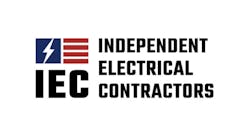Timeless Tips for Terminating Aluminum Cables
Nov 1, 1999 12:00 PM, Edited by John A. DeDad, Editorial Director
If you follow practical guidelines for installing and terminating aluminum cables, using these conductors makes sense in many applications.
Remember the "problem areas" related to using aluminum conductors in the past? Most of them date back to the use of older alloys, such as Alloy 1350.
Today, things have changed. With continued improvements in performance with new alloys, the use of aluminum conductors is now a viable alternative in many applications; if you properly install and terminate them.
The following five categories cover the basics of good installation practices when making connections with aluminum conductors. These rules vary per type of connector and termination material selected.
Mechanical screw-type connectors:
• Use dual-rated (AL7CU or AL9CU) connectors, listed by UL for use with aluminum and copper conductors, and sized to accept aluminum conductors of the ampacity specified.
• Use a suitable stripping tool to avoid damaging the conductor and remove the required length of insulation.
• Wire brush the conductor and apply a listed joint compound.
• Tighten the connection per the manufacturer's recommendation.
• Wipe off excess joint compound.
Mechanical compression-type connectors:
• Use dual-rated (AL7CU or AL9CU) connectors, listed by UL for use with aluminum and copper conductors, and sized to accept aluminum conductors of the ampacity specified.
• Use lugs marked with wire size, die index, number, and location of crimps, and suitably color coded. The lug barrel must be factory prefilled with a joint compound listed by UL.
• Use a stripping tool to avoid damaging the conductor and remove the required length of insulation.
• Wire brush the conductor.
• Crimp the connection per the manufacturer's recommendation.
• Wipe off excess joint compound.
Termination of aluminum conductor to aluminum bus:
• Prepare a compression connection as per the procedure outlined above for mechanical screw- or compression-type connectors.
• Use anodized alloy 2024-T4 bolts that conform to ANSI B18.2.1 and ASTM B211 or B221 chemical and mechanical property limits.
• Use aluminum alloy 6061-T6 or 6262-T9 nuts that conform to ANSI B18.2.2.
• Use flat aluminum alloy 2024-T4, Type A plain, standard wide series washers that conform to ANSI B27.2.
• Lubricate and tighten hardware as per the manufacturer's recommendations.
Termination of aluminum conductor to copper bus:
• Prepare a compression connection conforming to the procedure outlined above for mechanical screw- or compression-type connectors.
• Use plated or galvanized medium carbon steel; heat treated, quenched, and tempered bolts equal to ASTM A-325 or SAE Grade 5.
• Use heavy, semi-finished, hexagon nuts that conform to ANSI B18.2.2; threads to be unified coarse series (UNC), Class 2B.
• Use steel, Type A, plain standard wide series washers that conform to ANSI B27.2.
• Use Belleville conical spring washers of hardened steel, cadmium plated, or silicone bronze.
• Lubricate and tighten hardware as per the manufacturer's recommendations.
Termination of aluminum conductor to equipment not equipped for termination of aluminum conductor:
• Prepare compression connection using an adapter listed by UL for this purpose, or by pigtailing a short length of suitable sized copper conductor to the aluminum conductor with a compression connector listed by UL.
• Provide an insulating cover over adapter body or compression connector.
• Terminate the adapter or the pigtail onto the equipment per manufacturer's recommendations.
Sidebar: Connector tests
Tests have proven properly made connections of AA-8000 series aluminum conductors perform as well as those made with electrically equivalent copper conductors.
Listed connectors for use with aluminum conductors have to meet the requirements of UL Standard 486B. In particular, UL uses the accelerated performance evaluation test (such as the current cycling test described in this standard) to assess the stability of the connector-and-conductor combination. Further, UL also evaluates most connectors listed in accordance with this standard for use with copper conductors and marked, for example "AL7CU" or "AL9CU."
Many utilities use the same or similar connectors. To approve them for their use, utilities rely on a similar assessment in accordance with the ANSI C119.4 Standard. The current cycling test, per this standard, is more severe than the UL 486B test, and it uses bare conductors. Conductors and cables of AA-8000 series of electrical-grade of aluminum alloy conductor material are recognized in the National Electrical Code Sec. 310-14 (Aluminum Conductor Material).
Sidebar: What do the alloy numbers mean?
According to the Aluminum Electrical Conductor Handbook, manufacturers list aluminum and aluminum alloys according to the major alloying element. They designate alloys by a four-digit numbering system. The first digit designates the major alloying element; the remaining three digits represent modifications to the basic alloy, according to its registration with The Aluminum Association. Back in the late '70s and early '80s, Aluminum 1350 was the most widely used form of aluminum for electrical conductors. We're now into the 8000 series of aluminum alloy, which has much better conductivity, creep resistance, strength, and workability.


